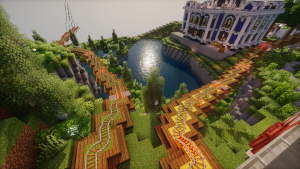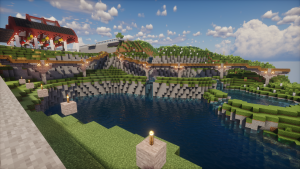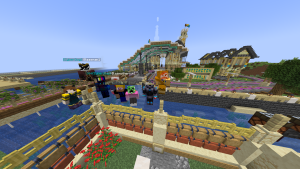Guide
How to contribute to the Survival Railway Network
From Dogcraft Wiki
This page contains all the information needed to contribute and/or connect to the Survival Railway Network (SRN). The page describes the difference between main line and branch line stations and the guidelines for building these and the rail lines as well as how else you can contribute to the SRN.
Stations
Stations are the stopping points for the SRN. Stations are generally builds with minecart systems in them and rail lines connected to them that allow players riding the rail line to get into or exit the minecart.
Stations are mostly built at player or group bases or in other interesting locations. Stations can be no more then approximately 2000 blocks apart, as if the journey from one station to the next takes over 5 minutes, there is a risk of players getting kicked by the afk kicker due to inactivity while riding the rail line. A shorter distance of 1000 to 1500 blocks between stations is generally preferred and most stations fall in this category.
Stations can generally be categorized as main line or branch line stations. The term main line is used for the 4 cardinal directions from spawn on each world, meaning the North, East, South and West lines leaving the Grand Central Station of each world are considered the main lines. All lines that branch off of these somewhere are considered branch lines. In Survival 5 the term of ring lines was introduced as a subset of branch lines. The ring lines are large branch lines connecting the 4 main lines on a world together and thus forming a great ring around the center of the world. Generally main lines have been held to a higher standard then branch lines in the past, but in recent years with so many talented builders on the server, branch lines have at times seen stations bigger and better then some main line stations.
Building a rail station
If you wish to build any rail station or want to connect your base to the network, this section lists the requirements and design considerations for rail stations.
The first step to building a rail station is to get in contact with the SRN.
If you are just looking for a building project and a rail station is something you want to try and build, but dont have a specific location in mind or dont care where you will be building it, check out the #open-tasks channel in the Dogcraft Transport Discord. Here Line Managers will sometimes look for someone to build a station in a specific location. A post in this channel will also directly tell you who exactly to contact if you are interested in the given task.
If you want to connect your base or build or some other specific location to the SRN, get the coordinates of the location and the world it is on and approach any SRN Line Manager or Conductor and they will be able to point you to the correct person. Alternatively you can also check in the Transport Discord which Line Manager is responsible for your area and directly contact them. The Line Manager will look at your location and inform you whether or not a direct connection is possible, if you may need to get your neighbours in the boat as well in order to connect or if you are to far away to connect to the network. As with the SRN we have to not only build the stations but also the lines in between them, we are unfortunately not going to be able to reach places that are tens of thousands of blocks away from spawn as we simply do not have enough time to build all the lines and stations required to get there. Be aware that for branch line stations, the responsible Line Manager may expect you to also build the rail line connecting your station to the nearest other rail station. Luckily the community is always happy to help out if you need help with building a long rail line!
If you have received confirmation from the SRN that you can build your station, you can start to work straight away. To properly function as a rail station there are certain requirements for your build that will have to be met.
Here is a list of requirements for a SRN rail station:
- Functional minecart dispenser systems (see below)
- Connections for at least 1 (on branch lines) or 4 (on main lines) rail lines
- The entire build (including roofs) needs to be spawn proof
- Beds
- Ender Chests
- A nether portal connected to the NTN (if a publicly accessible portal is nearby and signage is provided to get there, that is fine)
- At least 1 copy of the network map (this can be provided by the Line Managers)
- SRN Banners (you can get them from the Line Managers or at Banner Station on Sheltie)
- A map of the surrounding area
- Stations need to be easily navigable (in other words everything has to be easy to find. If locations might not be easily visible, use signs to point players in the correct direction)
The following points are not required, but are nice to have:
Very important for the design of the station are of course the location and size of the rail lines, but also the location and size of the minecart dispenser system. The rail lines are typically three blocks wide (the rails themselves and a stair block to either side) and there should be at least one block of air above the block that has the rails at the bottom of it, so players dont glitch through blocks.The minecart dispenser system
This paragraph explains how to build a typical minecart dispenser system for the SRN. If you still feel uncomfortable building this yourself, ask a SRN Line Manager or Conductor for help and they will usually be happy to build this for you.
A note on the size of the minecart dispenser system: In order to fit a minecart dispenser system, there has to be a gap of at least 7 blocks between the trapdoors of two opposing tracks and a gap of a minimum of two blocks between adjacent and parallel tracks is required.
The minecart dispenser system in a typical SRN station consists of the rail line with a activator rail and a detector rail (though these may not be touching) leading to a set of three trapdoors (typically iron) where the detector rail is located right in front of the first trapdoor above ground and a redstone system with a dispenser, a cactus, powered rails, hoppers and typically a double chest underground.
The rail will go downwards on a slope from the trapdoors into the redstone system where they will then go up by one block again and then lead directly to a cactus. Incoming minecarts will come through the trapdoor, go down the track and into the cactus which will break the minecart. A hopper underneath the rail that is directly in front of the cactus will pick up the minecart item once the cart is broken by the cactus. The hopper will transfer the item into a double chest typically located directly next to it. Underneath the double chest another hopper is located that transfers minecarts out of the chest into a dispenser, which is located under the track and pointing up. The rail on a slope directly on top of the dispenser is a powered rail as is at least one more rail on the slope up to the trapdoors. These need to be powered by a redstone source like a redstone torch or lever. These rails provide the speed for the minecart leaving the system, which has to be fast enough so the minecart makes it up through the trapdoors and slow enough so people can catch it and get in before it drives off down the track. The speed can be somewhat adjusted by adding additional powered rails on the slope.
Finally a redstone wire coming from the button on the surface where players can request a minecart has to be connected to the dispenser and via a timer to the activator rail. The activator rail is typically powered and needs to be unpowered for a few seconds when a minecart leaves the system, so players getting into the minecart quickly dont get immediately ejected again once they hit the activator rail.
This is a typical minecart dispenser system, but many variations of this are possible. As long as the system used kicks arriving players out of the minecart and provides a way to request a new minecart for those wanting to leave the station it will work for the SRN, but please check in with a Line Manager and get confirmation from them before opening a station with a new design for the minecart dispenser system.Rail lines
Rail lines on the SRN connect stations with each other. They are what the minecart travels on between the stations. The SRN uses a point to point connection for its station, meaning that each rail line runs from one station to one other station. There are no "switches" or possibilities to change to a different rail or direction between stations. Usually there also are no stops between two stations, though occasionally small "stops" that just serve to get onto the rail but not to get off have been built in the past.
This all means that if you have just built a station, you now need at least one rail line to connect to the nearest other station, even if there is a rail line already running nearby, you cant just "branch off" it somewhere. As mentioned above, the nearest station from your new station should ideally be within about 1500 blocks, but slightly further can also work.
Usually the hardest task about building a rail line is to map out the route that the line will take, as rail lines are not exempt from the 100 block rule and therefore have to stay at least 100 blocks away from other builds or get permission from the owner of the build to run closer. Additionally building rail lines over large bodies of water or through high mountains can be much harder then building it over relatively flat ground and riding a rail line on a very long bridge or through a long tunnel can be boring as well. For these reasons most Line Manager often avoid this by building rail lines around oceans or mountains instead of through or over them. Usually Line Managers will mark where a future rail line will run with pillars of netherrack or stone brick or other cheap but not naturally occurring blocks so it is easy for other players to see that something is planned there.
With all the planning done, construction on the rail line can start.
Most rail lines are three blocks wide and elevated several blocks above the ground. Lines are elevated above the ground to prevent mobs from walking onto the rail line at night. The line itself is spawn proof by design. The usual construction consist of a line of blocks (usually stone bricks) with colored concrete powder (the color indicating the direction) on top and stairs (usually spruce) to the sides with the actual rails being placed on top of the concrete powder. About every 16 blocks a pillar holding up the rail line is located. These are usually constructed from stone bricks and feature lit redstone lamps at the top. They also have at least one redstone torch hidden underneath the concrete powder and a powered rail instead of the regular rail to keep the minecart running at good speed.
Special care must be taken when building long stretches of diagonal line and when building sloped pieces of rail line. Long diagonals have to be broken up by the occasional single bit of straight track as powered rails cannot curve and are necessary in regular intervals to keep the minecart at speed. Sloped pieces of track require additional powered rails as a minecart will need to be able to go up the slope all the way to the top.
Generally it is always a good idea to test a rail line while you are building it. Just take a minecart place it near a powered rail, get in and ride the line. This is the best way to see if you have enough powered rails. But keep in mind that a minecart with a player in it needs fewer powered rails then a empty minecart to stay at speed!
Branch and Main lines
In general branch lines and main lines are very similar, with branch lines using different colors then main lines and generally branch lines being pretty much completely free in design where main lines mostly follow the some basic design. Main lines are usually built by a Line Manager (often with the help of a build session) and branch lines are often built by other players, but the reverse is also possible.
In summary branch lines and main lines are very similar, but while main lines often follow the same basic design with stone bricks and spruce, branch line can be freely design with no restrictions on the blocks used or similar as long as it is spawn proof, save from mobs and not too long.Build Sessions and Donations
If you want to contribute to the SRN but do not want to build a station or line yourself, keep an eye on the transport discord as we often have build session for long rail lines where everyone is welcome to join and help build a rail line. At every build session there will be at least one Line Manager present to explain what needs to be done, resources are usually provided and with many people showing up, lines are often completed very quickly.
These build sessions can be not only a way to learn about the rail lines on the server, but also a great way to get to know people and start forming friendships! Even if you are not comfortable speaking in the voice chat, consider joining it anyways and just muting yourself. That way you can still listen to the conversations and participate in them using the ingame chat or the "muted" text channel in discord. The main goal of the build sessions is for everyone to have fun while building something together!
Additionally the SRN is often looking for donations of materials. If we need something specific we will usually post it in the srn-general or open-tasks channel in the transport discord, but even if nothing is posted, feel free to ask on the discord. We can almost always use iron and gold for rails and spruce for stairs.
Donations can be dropped off at the phome XPModder.DT-HQ






